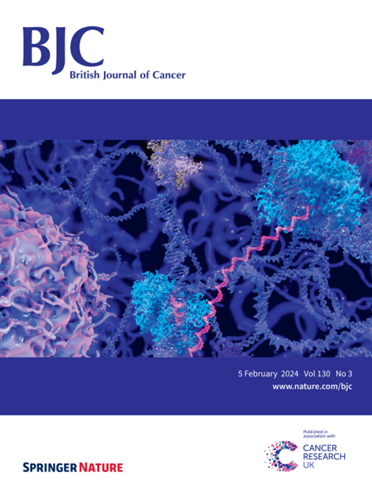6种癌症的异构体水平分析揭示了在基因水平上未被发现的广泛的遗传风险机制。
IF 6.8
1区 医学
Q1 ONCOLOGY
引用次数: 0
摘要
背景:整合全基因组关联研究(GWAS)和转录组学数据集可以识别癌症遗传风险的介质。传统的方法往往是不够的,因为它们依赖于总基因表达的测量,而忽略了选择性剪接,这产生了不同的转录异构体,具有潜在的不同效果。方法:我们将来自基因型组织表达项目的多组织异构体表达数据与GWAS汇总统计(所有N bbb ~20,000例)相结合,以确定六种癌症(乳腺癌,子宫内膜癌,结肠直肠癌,肺癌,卵巢癌,前列腺癌)和六种相关癌症亚型分类(N = 12)的异构体和基因水平相关性。结果:与基因水平的方法相比,使用转录组全关联研究(isoTWAS)直接建模同种异构体显著提高了遗传关联的发现,鉴定出164%的显著关联(6163对2336),isoTWAS优先基因在进化受限基因中富集了4倍。在6种癌症中,isoTWAS标记了52%的独立GWAS位点的转录组关联。与基因表达相比,异构体表达介导的癌症风险SNP遗传率估计高出63%。我们强调了几个isoTWAS关联,这些关联表明GWAS在异构体水平而不是在基因水平上共定位,包括CLPTM1L(肺癌)、LAMC1(结直肠癌)和BABAM1(乳腺癌)。结论:这些结果强调了对同种异构体建模对于最大限度地发现癌症遗传风险机制的重要性。本文章由计算机程序翻译,如有差异,请以英文原文为准。

Isoform-level analyses of 6 cancers uncover extensive genetic risk mechanisms undetected at the gene-level
Integrating genome-wide association study (GWAS) and transcriptomic datasets can identify mediators for genetic risk of cancer. Traditional methods often are insufficient as they rely on total gene expression measures and overlook alternative splicing, which generates different transcript-isoforms with potentially distinct effects. We integrate multi-tissue isoform expression data from the Genotype Tissue-Expression Project with GWAS summary statistics (all N > ~20,000 cases) to identify isoform- and gene-level associations with six cancers (breast, endometrial, colorectal, lung, ovarian, prostate) and six related cancer subtype classifications (N = 12 total). Directly modeling isoforms using transcriptome-wide association studies (isoTWAS) significantly improves discovery of genetic associations compared to gene-level approaches, identifying 164% more significant associations (6163 vs. 2336) with isoTWAS-prioritized genes enriched 4-fold for evolutionarily-constrained genes. isoTWAS tags transcriptomic associations at 52% more independent GWAS loci across the six cancers. Isoform expression mediates an estimated 63% greater proportion of cancer risk SNP heritability compared to gene expression. We highlight several isoTWAS associations that demonstrate GWAS colocalization at the isoform level but not at the gene level, including CLPTM1L (lung cancer), LAMC1 (colorectal), and BABAM1 (breast). These results underscore the importance of modeling isoforms to maximize discovery of genetic risk mechanisms for cancers.
求助全文
通过发布文献求助,成功后即可免费获取论文全文。
去求助
来源期刊

British Journal of Cancer
医学-肿瘤学
CiteScore
15.10
自引率
1.10%
发文量
383
审稿时长
6 months
期刊介绍:
The British Journal of Cancer is one of the most-cited general cancer journals, publishing significant advances in translational and clinical cancer research.It also publishes high-quality reviews and thought-provoking comment on all aspects of cancer prevention,diagnosis and treatment.
 求助内容:
求助内容: 应助结果提醒方式:
应助结果提醒方式:


